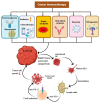Role of Immune Cells and Receptors in Cancer Treatment: An Immunotherapeutic Approach
- PMID: 36146572
- PMCID: PMC9502517
- DOI: 10.3390/vaccines10091493
Role of Immune Cells and Receptors in Cancer Treatment: An Immunotherapeutic Approach
Abstract
Cancer immunotherapy moderates the immune system's ability to fight cancer. Due to its extreme complexity, scientists are working to put together all the puzzle pieces to get a clearer picture of the immune system. Shreds of available evidence show the connection between cancer and the immune system. Immune responses to tumors and lymphoid malignancies are influenced by B cells, γδT cells, NK cells, and dendritic cells (DCs). Cancer immunotherapy, which encompasses adoptive cancer therapy, monoclonal antibodies (mAbs), immune checkpoint therapy, and CART cells, has revolutionized contemporary cancer treatment. This article reviews recent developments in immune cell regulation and cancer immunotherapy. Various options are available to treat many diseases, particularly cancer, due to the progress in various immunotherapies, such as monoclonal antibodies, recombinant proteins, vaccinations (both preventative and curative), cellular immunotherapies, and cytokines.
Keywords: CART cell; cancer; checkpoints; combination therapy; immune cells; immunotherapy; monoclonal Abs.
Conflict of interest statement
The authors declare no potential conflicts of interest concerning the research presented in this article, authorship, and publication.
Figures


References
Publication types
LinkOut - more resources
Full Text Sources

